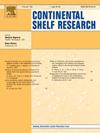Polycyclic aromatic hydrocarbons and their derivatives in sediments from the Okinawa Trough and South China Sea: Occurrence, sources, profiles, and implications for anthropogenic activities
IF 2.2
3区 地球科学
Q2 OCEANOGRAPHY
引用次数: 0
Abstract
Sediments from the Middle Okinawa Trough (MOT) and Southwest Basin were analyzed for polycyclic aromatic hydrocarbons (PAHs) and their halogenated and nitrated derivatives. No halogenated PAHs were detected, whereas 6 nitrated PAHs were observed in three samples from the MOT (0.960−6.46 ng/g). The concentrations of Σ18PAH in the sediment of the MOT (average124 ng/g) were statistically higher than those of the Southwest Basin (39.7 ng/g). The MOT sediments were dominated by 4−5-ring PAHs, whereas the Southwest Basin sediments were dominated by 3-ring PAHs. The regional differences in concentrations and composition profiles were likely due to the different patterns of regional environmental and/or anthropogenic factors, e.g., climate and energy consumption. Sedimentary PAHs in the MOT were primarily derived from petroleum and/or petroleum combustion, while those in the Southwest Basin were mainly from petroleum. The findings suggest that environmental management and pollution control strategies should consider the specific pollution source in different regions.

冲绳海槽和南海沉积物中的多环芳烃及其衍生物:赋存、来源、剖面及其对人类活动的影响
对冲绳海槽中部和西南盆地沉积物中的多环芳烃(PAHs)及其卤化和硝化衍生物进行了分析。3份样品中未检出卤代多环芳烃,但有6种硝化多环芳烃(0.960 ~ 6.46 ng/g)。MOT沉积物中Σ18PAH的浓度(平均124 ng/g)显著高于西南盆地(39.7 ng/g)。MOT沉积物以4 ~ 5环多环芳烃为主,而西南盆地沉积物以3环多环芳烃为主。浓度和组成概况的区域差异很可能是由于区域环境和/或人为因素(例如气候和能源消耗)的不同模式。MOT沉积多环芳烃主要来源于石油和/或石油燃烧,而西南盆地沉积多环芳烃主要来源于石油。研究结果表明,环境管理和污染控制策略应考虑不同区域的具体污染源。
本文章由计算机程序翻译,如有差异,请以英文原文为准。
求助全文
约1分钟内获得全文
求助全文
来源期刊

Continental Shelf Research
地学-海洋学
CiteScore
4.30
自引率
4.30%
发文量
136
审稿时长
6.1 months
期刊介绍:
Continental Shelf Research publishes articles dealing with the biological, chemical, geological and physical oceanography of the shallow marine environment, from coastal and estuarine waters out to the shelf break. The continental shelf is a critical environment within the land-ocean continuum, and many processes, functions and problems in the continental shelf are driven by terrestrial inputs transported through the rivers and estuaries to the coastal and continental shelf areas. Manuscripts that deal with these topics must make a clear link to the continental shelf. Examples of research areas include:
Physical sedimentology and geomorphology
Geochemistry of the coastal ocean (inorganic and organic)
Marine environment and anthropogenic effects
Interaction of physical dynamics with natural and manmade shoreline features
Benthic, phytoplankton and zooplankton ecology
Coastal water and sediment quality, and ecosystem health
Benthic-pelagic coupling (physical and biogeochemical)
Interactions between physical dynamics (waves, currents, mixing, etc.) and biogeochemical cycles
Estuarine, coastal and shelf sea modelling and process studies.
 求助内容:
求助内容: 应助结果提醒方式:
应助结果提醒方式:


